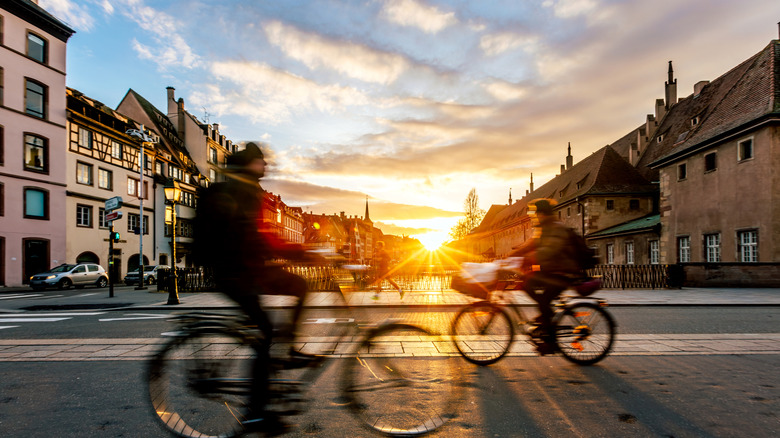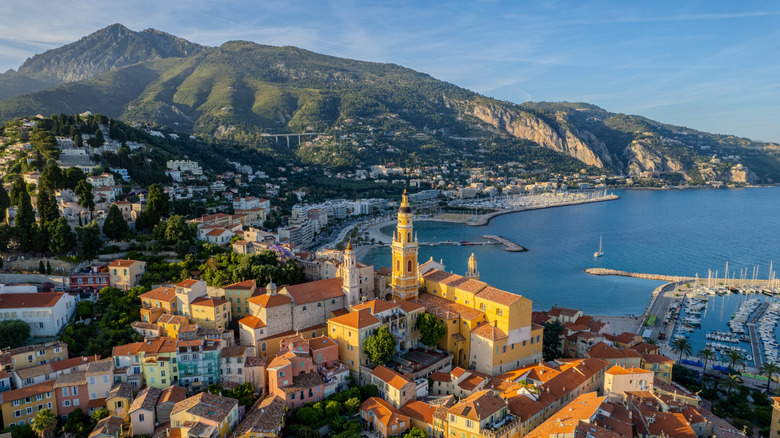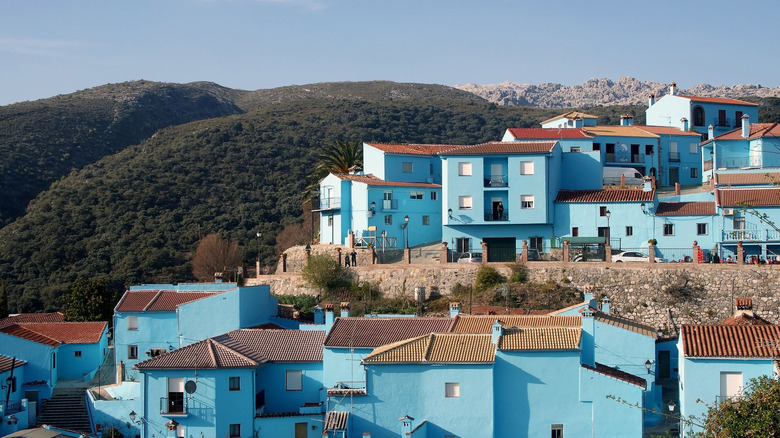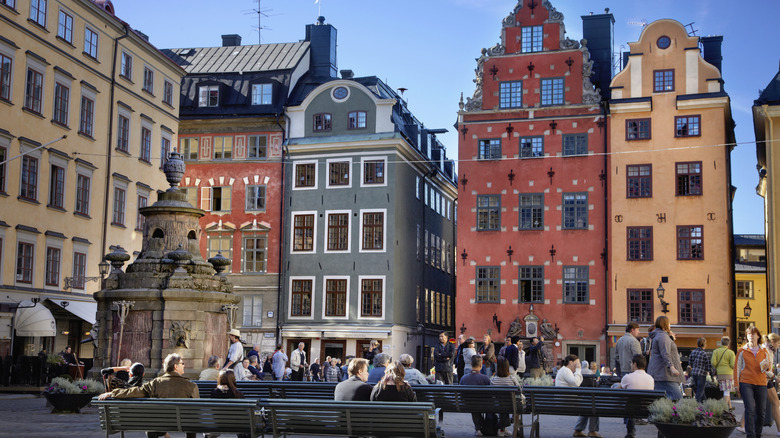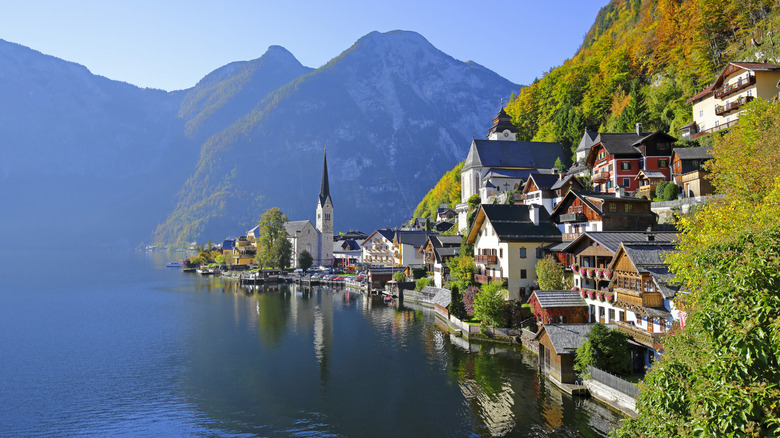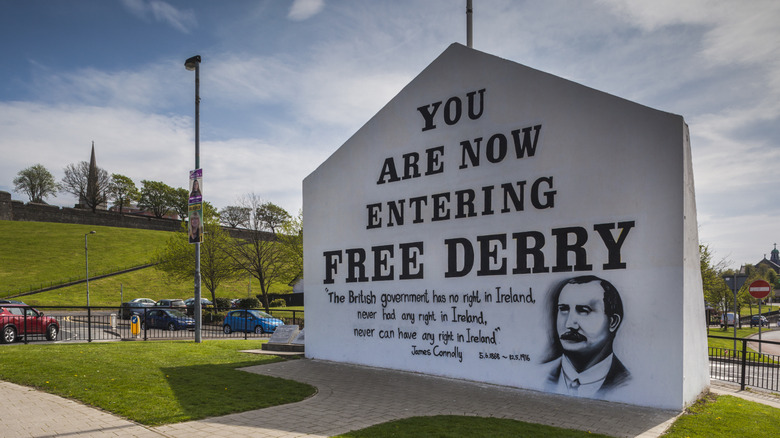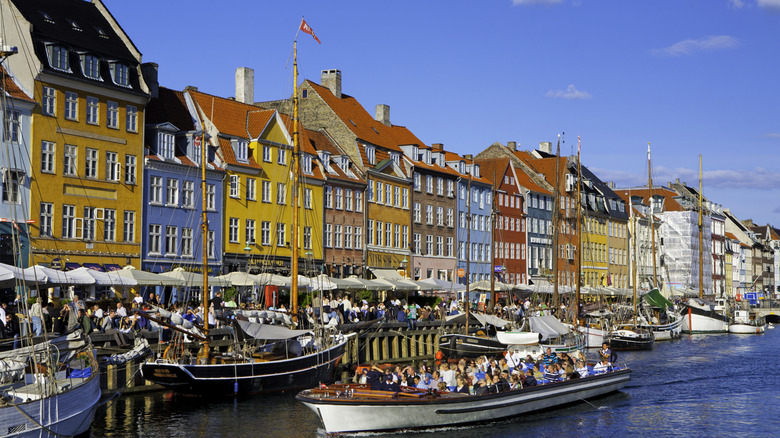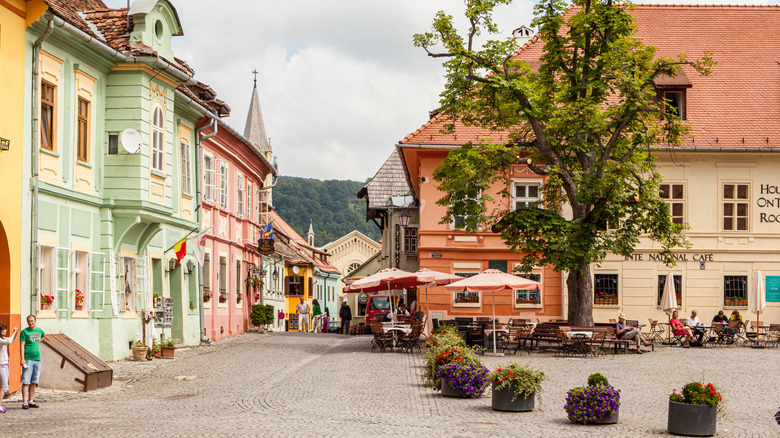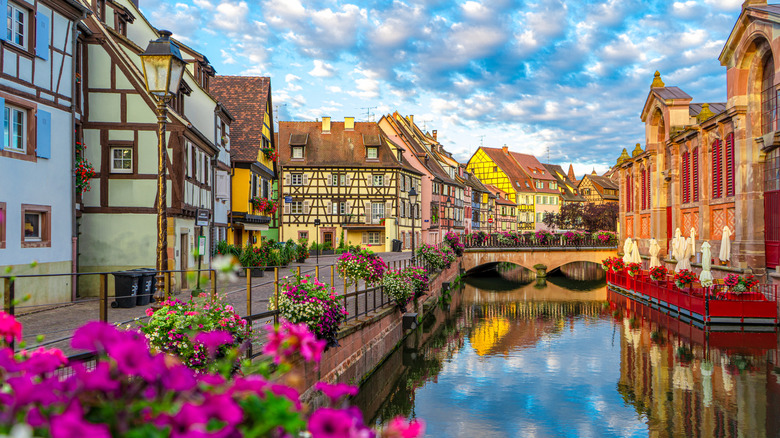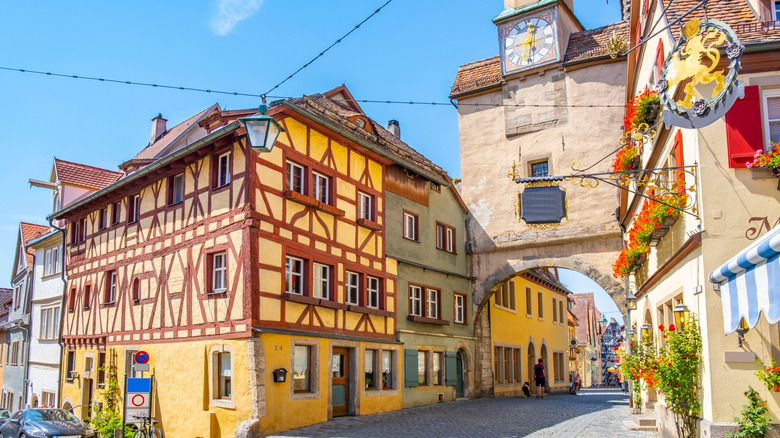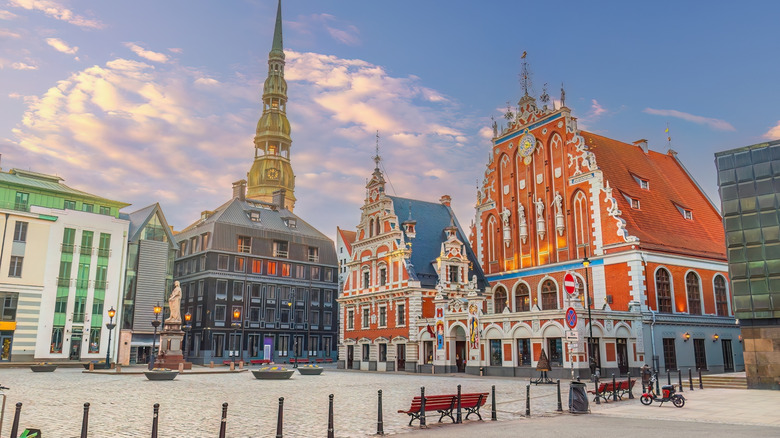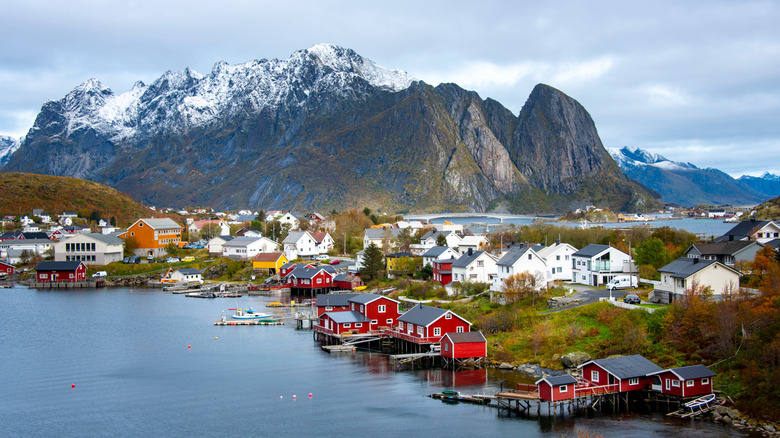The Most Colorful And Quirky Towns In Europe
A visit to Europe is a special thing. Americans travel in droves to the continent just across the ocean, exploring an old-world mystique and often some personal heritage all the same. Many Americans can confidently trace their roots back to an ancestral home somewhere in Europe — in most cases, countries such as England, Ireland, and Germany. Even with ancestry remaining a complex recombination of a huge variety of unique components of identity, Europe looms large in the American psyche.
For extensive reasons, Europe is a fascinating destination with pockets of uniqueness bursting out of a continent brimming with microclimates, both geographically and within its diverse population. Across 44 countries, Europe lays down a gauntlet of culture, history, and natural majesty. From the snowcapped peaks of the Swiss Alps to the shimmering Lake District in the U.K., the natural beauty of the continent is astounding.
But natural scenes aren't the only thing to marvel at here. Europeans have been particularly clever builders throughout the ages. A visit to just about any part of the continent will bring you into close contact with stunning architecture that leaves your head spinning. Small-town vistas are perhaps the bread and butter of the European spectacle, and there's plenty to choose from, including gems like Hallstatt, Júzcar, and even larger communities like Copenhagen. These are some of the most interesting and vibrant places to kick your next adventure into high gear.
Menton, France
Menton is a small town sheltered away along France's Côte d'Azur. It's roughly 18.3 miles west of Nice, just a stone's throw past the city-state Monaco, one of just five countries without an airport. Menton offers itself as a cost-effective option to explore this fascinating part of France. Quirky is perhaps an apt description of the town. As is the case across much of borderland France, the atmosphere can feel distinctly un-French. Places like Strasbourg and Perpignan deliver a decidedly blended experience in which German and Catalan (and Spanish) traditions and identity bleed over. The same can be said for Menton, where a quasi-Italian vibe carries the day.
As you'll find all along the blue coastline, Menton is a beach town thrown down along the hilly coast. It's a small community of roughly 30,000 people and one of the warmest spots along this stretch of Mediterranean coastline. Lemons are an integral part of what makes Menton special, just as the lavender fields of the wider Provence region often characterize this part of the country. From narrow, winding streets to the glistening expanse of Menton's beach areas, the small town, often overshadowed by Nice and other magnetic draws along the coastline, is a must-see spectacle of charm.
Júzcar, Spain
The Spanish countryside is famous for its white towns. These communities feature a bleached-out appearance, with every building in the settlement painted white. White-washed mountain villages like Mijas Pueblo along the Mediterranean often capture the attention and imagination of eager travelers, but there's another unique option in the cards. The Andalusian village of Júzcar features a brilliant blue hue rather than the traditional color. Painted blue in 2011 to coincide with the release of "The Smurfs," Júzcar remains a bright aqua and is frequently referred to as Spain's Smurf village.
There are a little over 200 residents of Júzcar, and significant levels of unemployment in part prompted the decision to take this perhaps drastic step to impart a truly odd character into the architecture. The change has drawn a significant volume of tourists in the years since. The strangeness of an all-blue village tucked away in the Spanish mountains in the country's southern warmth is too much to pass up. The tourist boost has been critical to the town's local economy, too, so visitors hoping to add this to their road-tripping list will be happy to learn that it's still coated in gallons of blue paint.
Stockholm, Sweden
Stockholm is a capital city with a small-town charm — the reason it appears on this list. The coastal community can be found sprawled across more than a dozen islands within the final exit of the freshwater Lake Mälaren into the salty Baltic Sea. The city has been here since 1252, making it something of an older fixture within the world of European settlement. Regal governorship through antiquity and into the present has imbued the northern gem with an air of aristocracy. Modern Stockholm features plenty of enticing treasures, as well as good public transportation and clean streets. It's a treat to trudge across Stockholm's contemporary cityscape, whether during the seasonal highs of summer or in the depths of winter.
The Swedish capital sports a total population, including the surrounding metro area, of around 1.7 million. Yet, it is a place that can feel equally quaint and intimate while providing the bones of a humming urban oasis. The attractions in Stockholm are really what you make of it. Spending your days traversing the museums and heritage sites (UNESCO marks the Viking communities in the area) or exploring the music, restaurant, and bar scenes of the city are equally viable approaches. Parks and other outdoor living spaces are also a key part of the modern community's makeup, and those looking for fresh air amid the colorful infrastructure will have their pick, too.
Hallstatt, Austria
Hallstatt is another water's edge community that sees its foundation stretch back into antiquity. However, this Austrian village can trace its community much farther back into the ancient world than most. Hallstatt lends its name to a civilization that thrived throughout central Europe thousands of years ago. The town itself has served humanity as a salt harvesting community starting roughly 7,000 years ago (in other words, about 2,000 years before the formation of Ancient Egypt). Hallstatt is home to the world's oldest salt mine; the name itself means the "place of salt."
Hallstatt is a prototypical Alpine village. Swiss and Austrian towns along this ridge of mountainous terrain frequently find themselves tucked against glacial lakes left over from the last ice age, and they deliver oodles of natural beauty that's hard to compare anything else to. Hallstatt finds itself surrounded by a healthy peppering of Austrian ski towns, too, making it a quality stopover destination as you explore the adventurous side of the Austrian countryside. Architecture here features classic Alpine aesthetics, and plenty of brilliant color palates come together in the often snowy and misty lakeside community.
Derry, Northern Ireland
Derry is a walled city on a hill. It overlooks the River Foyle, a waterway that historically separated much of the Catholic population from their Protestant neighbors. Derry is a city with immense history, established as a permanent settlement by St. Columba in A.D. 546. It wasn't until 1613 that Londonderry was formed as a royal charter city. The city walls were constructed over the next few years, and the city that now features two names (Derry and Londonderry) became a modern precursor to the community you can visit today. A major center of activity during The Troubles, Derry is perhaps as magnetic a landscape as the Peace Walls of Belfast (sometimes known as the Irish "Second City" that you shouldn't sleep on when planning a visit).
Derry is the only walled city on the island of Ireland with completely intact walls, making it a unique fixture in the landscape. It's also a uniquely blended space that showcases visible roots aligned with both sides of the national issue of independence from the U.K. One of the main draws for visitors is the murals located along the Catholic side of the town. Throughout the entryways into the neighborhoods that run away from the main town center are buildings adorned with murals depicting themes of The Troubles. The most notable element has to be the Free Derry sign, however. It's frequently repainted with new color schemes and themes to give it a fresh perspective on life and the vibrant community that makes up the town.
Copenhagen, Denmark
The Danish capital city shouldn't be a surprise inclusion here. The maritime haven of activity is easy to get to and immensely inviting. The spirit of the community shines through, and plenty of colorful and cozy buildings are waiting to welcome visitors to the city. It's even said that Copenhagen served as the inspiration for Walt Disney's original Disneyland theme park.
Nyhavn is a place for visitors seeking a quirky atmosphere and a splash of vibrant color. It's the waterfront canal district that dates back to around 1670. Today, some of the most well-known images of the city shimmering in bright daylight are taken in Nyhavn. It once offered itself as a waystation between incoming ships, bringing good to the city and the community beyond the port.
The townhouses here are dashed in all shades of color, and many date back from the 17ᵗʰ century to the beginning of the 18th century, standing proud throughout Denmark's more recent history. Food and drink options are also abundant here, giving you the ability to sit down amid the color and have a drink or grab a meal in an eclectic and warmly welcoming style.
Sighişoara, Romania
Sighişoara is a Romanian town that was founded by Transylvania's Saxon population. It has stood here since at least 1280, and the oldest building in the Romanian city is Casa Vlad Dracul. Indeed, an integral component of Bram Stoker's "Dracula" inspiration hails from this ancient Romanian city. Today, the town is home to roughly 28,000 people, giving it a small-town vibe many visitors looking for substance and old-world charm crave.
The old town has been named a UNESCO World Heritage Site as a result of its longstanding history as a stable example of Transylvanian Saxon culture. It's a fortified, medieval city that remains largely intact. On top of the beauty and history the community exudes, Sighişoara is also a cost-effective place to visit. Stretching your dollar a little further while exploring some of Europe's most breathtaking scenery is a combination that is sure to delight just about anyone, making this a quality, must-visit addition to your European travel list.
Colmar, France
Colmar is another French city that features crossover influences from the nation's neighbor. It has a small-town feel and is tucked near the German border. Colmar showcases visible German influences in its architecture, food, and more. As a historic French city near Germany, it's potentially surprising to some to learn that it was spared the destructive fate that befell many other countryside communities during World War II. Colmar was spared in large part due to a mutual respect for the idyllic beauty of the community.
It features half-timbered architecture infinitely reminiscent of rural German building practices and cobblestone lanes that invoke massive fairytale themes. Canals abound throughout the city, and Colmar stands as one of France's most inviting inland treasures for visitors seeking a thematic step back in time. Colmar isn't the place to be if you're looking for active nightlife and plenty of bars to explore. Yet, travelers seeking blasts of colorful buildings and a different kind of vibe often understand that the tradeoff is worth it — or appreciate a diversion to a city like this.
The city center and La Petite Venise (Little Venice) are must-see features of the city. Free walking tours are available to visitors, too, offering a great way to explore this tight-knit and truly beautiful community space. While beauty is abundant here, no matter when you visit, a stop in Colmar during the spring is a marvelous idea. You will experience breathtaking beauty as the city bursts with additional color; the flowers all around the city showcase brilliant pops of color, adding incredible splendor to its aesthetic.
Rothenburg ob der Tauber, Germany
Rothenburg is a fairly common name in Germany, so a basic map search for the town might give you directions to a different Rothenburg. The correct town you want to visit is Rothenburg ob der Tauber; it features half-timbered construction and iconic colors and is located on the Tauber River. It's the best-preserved walled community in the country and offers a dynamic and immediate portal back in time to a rural lifestyle and a not-so-interconnected era. That's not to say the town doesn't feature modern hallmarks of a great tourist draw. But the atmosphere that the city preserves is something truly remarkable. It's a medieval gem of German architecture that dates back to the 9th century.
The community eventually became a fortified town and stood as a free imperial city until 1803. Some of the most striking tourist draws include St. Jakob's Church, featuring an altarpiece that's 500 years old — an immaculate craft that's older than the United States! The Medieval Crime and Punishment Museum is also a big draw, as are the ornament shops and other souvenir options. Located about halfway between Frankfurt and Munich, Rothenburg ob der Tauber is an accessible stop during a road trip through this part of Germany or as a dedicated stop along a more streamlined route.
Riga, Latvia
Riga is a thriving capital city in the highly underrated Baltic region. The Baltic states offer a tapestry of amazing sights and sounds. One of the most spectacular spots in Riga can be found right in the city center. The House of the Blackheads stands prominently in the city's central square. It was built as a meeting place in 1334 for merchants working in the city. It's been rebuilt numerous times, including a complete renovation in 1999. Beyond this ancient gathering space, old-town Riga is a UNESCO Heritage Site. It features architecture from Gothic, Baroque, and other periods in European history that come together to form a majestic capital city tucked away from the Baltic Sea by the safety of the Gulf of Riga (and along the River Daugava).
Art is abundant here, and the architecture of the community adds to that DNA significantly. Roughly 40% of the old-style homes found throughout Riga were built in an Art Nouveau style, making the town a distinctly classy affair that drips classic artistic elements. There's even an Art Nouveau Museum for those looking to experience the building theme in even greater detail. Parks are also found throughout the city, giving visitors a break from the urban grind when the desire to sit down and breathe in a bit of nature strikes.
Reine, Norway
Reine is a fishing village found impossibly far north. The community is above the Arctic Circle and features a smattering of vibrant red fishermen's cabins juxtaposed perfectly alongside the deep blue waters below and the green mountainous peaks that rise into the surrounding landscape beyond. The trio of colors blends into a dynamic and enchanting scene that simply has to be experienced to be fully understood. Fortunately, many of the cottages have been converted into B&B-type temporary residences that welcome visitors for a night spent in awe of the impeccable nature of the stark northern climes.
The population of the tiny coastal community flung out along Norway's Lofoten Archipelago in the extreme north is just over 300, adding another wrinkle to the mystique of this remote, beautiful community. The fjords of the region can be felt to their full effect in a place like Reine, and visitors should anticipate a massively beautiful array of natural scenery. You might even find yourself lucky enough to experience the northern lights here without organizing a tour or any kind of specialized adventure to bring you to a place with little light pollution.
